Thursday, January 31, 2008
Services for Marc Mullenix Planned
Faith Bible Chapel
6250 Wright St.
Arvado, Colorado
map
Apparatus staging will begin at 1030 at the Faith Bible Chapel. Departments wishing to bring apparatus should contact Lt. Rick Goodman at 303-435-9411
A memorial fund is being established, the "Marc Mullenix Life Challenge Foundation". Details will be posted when they become available.
Flowers may be sent to:
Fairmount Fire
4755 Isabell Road
Golden, CO 80403
303-279-2928
Texas Governor Issues Disaster Proclamation for Fires
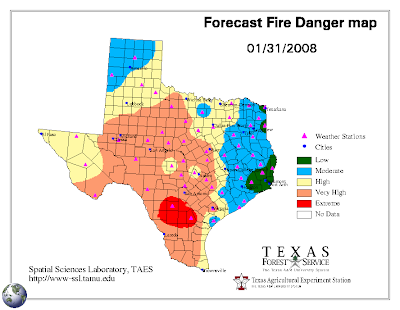
The AP reports:
"Gov. Rick Perry issued a disaster proclamation for more than half the counties in Texas on Wednesday because of wildfires that have already destroyed at least two dozen buildings and could do more damage later this week."The Texas State Operations Center in a Jan. 30 Situation Report said:
"To provide an effective response for fire suppression operations, several actions have been taken. The State Operations Center (SOC) has activated 8 aircraft from the Texas Military Forces. The Texas Forest Service (TFS) is deploying ground assets to threatened areas. The Texas Department of Transportation is providing fuel for fire fighting apparatus, a maintainer, a dozer, 21 other vehicles, 29 personnel, and 2 portable dynamic message signs."
It's interesting, that as this is written, the web sites for the Geographic Area Coordination Centers for the Southwest and Southern Areas are down. Update: the sites are working again.
(Map courtesy of the Texas Forest Service. Click on it to see a larger version.)
Tuesday, January 29, 2008
Marc Mullenix- RIP
Here is a link to a photo of Marc and short article that appeared on the US News and World Report web site.
If anyone has a good photo of Marc that we could place here, let me know... and include permission to use it.
Marc Mullenix--rest in peace.
Strong Winds in Texas Push Multiple Fires
Central Texas
Austin area
Denton County (northeast Texas)
Williamson County (central Texas)
Statewide
Monday, January 28, 2008
Flashlight That Can Start a Fire
Here is a flashlight that produces enough heat to start a fire, at least in paper and plastic. I wonder if it would be practical for burning out or backfiring in light fuels if you ran out of fusees or drip torch fuel? It costs about $300 and the battery only lasts 15 minutes, so maybe I just answered my own question. The website for the flashlight, WickedLasers, has received so many hits it is down, but it may be up later.
US Fire Experts Assist Kingdom of Bhutan
In case you are not familiar with the Kingdom of Bhutan (I had to look it up), it is a landlocked country sandwiched between India and China and is one of the most isolated and least developed nations in the world.
More information is HERE.
(Photo courtesy of the above website.)
Sunday, January 27, 2008
Glenn Beck: "...people who hate America... are losing their homes in a forest fire today."
 You may have heard of Glenn Beck. He appears on CNN Headline News and also has a nationally-syndicated radio show. I rarely agree with anything he says, but I just found out that on his October 22 radio show, while the Witch Creek, Harris, and other fires were burning in southern California, he said:
You may have heard of Glenn Beck. He appears on CNN Headline News and also has a nationally-syndicated radio show. I rarely agree with anything he says, but I just found out that on his October 22 radio show, while the Witch Creek, Harris, and other fires were burning in southern California, he said:"I think there is a handful of people who hate America. Unfortunately for them, a lot of them are losing their homes in a forest fire today."Both fires started in eastern San Diego county and were pushed by strong Santa Ana winds into the outskirts of San Diego. In the Harris and Witch Creek fires, a total of 1,246 homes burned, 7 people were killed, and a CalFire engine crew was entrapped and seriously burned.
Beck contradicted himself several times, but his rationale is that since California is predominantly a Democratic state, and since he believes that Democrats "hate America", that the homes of people who hate America were burning. Of course Beck is an idiot, but to say this while over 1,000 homes are burning and 500,000 residents are being evacuated is the height of irresponsibility, insensitivity, and stupidity.
According to Media Matters, Beck has also said
"it took me about a year to start hating the 9-11 victims' families" and referred to Hurricane Katrina survivors as "scumbags"(photo is of the Harris Fire burning on Mount San Miguel east of San Diego, October 23, 2007; from Wikipedia)
Saturday, January 26, 2008
Article About Current Issues in Wildland Fire
These two men show remarkable insight and candor in describing fire management strategy... what works and what doesn't. Weldon is quoted as saying:
"[The Ahorn] was a fire we went after very aggressively," Weldon says. "We put in a couple loads of smoke jumpers, a hotshot crew, aviation assets. We spent a lot of money on that fire. We exposed a lot of folks. We crashed a helicopter. We had a shelter deployment on that fire. Despite all that, we influenced that fire very minimally, and we spent $18 million trying."Weldon goes on to say:
"I think it is disrespectful to tell people we are going to protect their structures when we don't have the capability," he says. "What's different is that the environment we are living in and working in is going to demand that we look at it differently. I don't think we have a choice."A big thanks to Dick Mangan for the tip on this article.
OSHA and U.S. Forest Service Reach Settlement About Esperanza Fire

The Occupational Safety and Health Administration and the U.S. Forest Service have reached a settlement which modifies some of the "serious violations" that OSHA found after the Oct. 26, 2006 fire in which the five members of San Bernardino National Forest Engine 57 were killed during a burn over.
According to the Press-Enterprise:
"Under the settlement, two of the six violations were withdrawn and the four others were amended, said Jason Kirchner, public affairs specialist for the Pacific Southwest Region of the Forest Service.
Kirchner said the main issue for fire officials was that OSHA initially viewed some firefighting guidelines as safety rules that had been broken.
"We felt it was an incorrect assessment," Kirchner said. "They were not intended to be unbreakable rules. They are tools to help evaluate the situation and make decisions."
Kirchner said the remaining four serious violations have been addressed in the Esperanza Accident Review Board Action Plan that was devised by the Forest Service.
The serious violations showed the fire agency did not "furnish places and conditions of employment that were free from recognized hazards that were causing or likely to cause death or serious physical harm ..."
It noted that instructions from the branch director were either "poorly communicated, or misunderstood" by firefighters. Firefighters were not equipped with maps to familiarize themselves with the area and terrain. The report also noted that the firefighters were ordered to provide structure protection and ended up directly in the path of the strong winds and fire, resulting in the fatal burnover of their fire engine."
The crew of Engine 57: Capt. Mark Loutzenhiser, 43, of Idyllwild; Jess McLean, 27, of Beaumont; Jason McKay, 27, of Apple Valley; Daniel Hoover-Najera, 20, of San Jacinto; and Pablo Cerda, 23, of Fountain Valley.
(photo is from the official USFS/CalFire Factual Report)
Another "Blue Ribbon Task Force" Makes Recommendations in California
The second Blue Ribbon Commission Task Force in California since the fires of 2003 presented it's report yesterday about how to deal with large wildland fires in the state. The recommendations include more engines, more aircraft, more firefighters, fire safe construction, and better systems for real time communications and intelligence. Many of these were in the report following the 2003 fires but were not implemented because of the state's fiscal problems.
Click here to download the 106-page report (788 KB).
Here is how the LA Times began their story on the report:
Three months after massive brush fires burned hundreds of homes across Southern California, a blue-ribbon task force on Friday made dozens of recommendations aimed at improving the response to large-scale blazes.(photo by Bill Gabbert; taken in 2004 in Harbison Canyon, the area of the 2003 Cedar Fire east of San Diego.)
But many of the proposed measures are similar to those made after the devastating wildfires of 2003 -- and many of those were never implemented because there was no money available.
And because the state is in a fiscal crisis, it remains unclear whether the new recommendations will fare any better. Several reports over the last decade have said California needs to increase the number of firefighting aircraft as well as boost the number of firefighters.
Thursday, January 24, 2008
NWCG and U.S. Fire Administration Announce Wildland Fire Training Crosswalk for Structural Firefighters
From a press release issued yesterday by the U.S. Fire Administration:
"Emmitsburg, MD- Today, the U.S. Fire Administration in cooperation with the National Wildfire Coordinating Group, announced a new aid to help local and rural firefighters identify training equivalencies and needs for effectively fighting wildfires that threaten residential areas. The Skills Crosswalk identifies critical wildland firefighting skills that structural firefighters need to be safe and effective when making an initial attack on a wildland fire in their jurisdiction, or when working with state and federal wildland firefighter agencies.
“Our nation’s firefighters already have the necessary skills for fighting fires in all structures in a community," said U.S. Fire Administrator Greg Cade. "Structural training does not however always address the critical wildland fire suppression techniques which differ from structural firefighting techniques. The new Skills Crosswalk highlights the differences in order for structural firefighters to be able to address wildland fire suppression challenges.”
According to the U.S. Census Bureau 2006 report, in every area of the nation rural development is expanding into wildland areas. Since the 1980’s, the rural population has more than doubled, with 140 million people now living in rural areas. As a result, rural and volunteer firefighters increasingly manage fire in the Wildland/Urban Interface.
The new Skills Crosswalk provides a performance-based methodology and a learning resource guide for qualified structural firefighters to develop wildland firefighting knowledge and skills in a focused and time-efficient format. This methodology will assist structural firefighters with wildland skills in working more safely and effectively on initial and extended attack operations and enhance cooperative firefighting efforts with neighboring jurisdictions and federal wildland firefighters.
For more information, visit the Wildfire section of the U.S. Fire Administration’s Web site."
A big thank you to Greg Greenhoe for the tip on this."One Foot in the Black" Benefits Wildland Firefighter Foundation
 Kurt Kamm, "after studying fire science and spending three years with L.A. County Fire Department and CalFire crews", has written a book about wildland firefighters. "One Foot in the Black" is available on the Wildland Firefighter Foundation (WFF) web site. The proceeds from the book go to the WFF. I have not read the book, but the WFF is a wonderful organization that assists wildland firefighters and their families when they have experienced a serious line of duty injury or death. If you have read the book, leave a comment.
Kurt Kamm, "after studying fire science and spending three years with L.A. County Fire Department and CalFire crews", has written a book about wildland firefighters. "One Foot in the Black" is available on the Wildland Firefighter Foundation (WFF) web site. The proceeds from the book go to the WFF. I have not read the book, but the WFF is a wonderful organization that assists wildland firefighters and their families when they have experienced a serious line of duty injury or death. If you have read the book, leave a comment.Here is an excerpt from a review of the book.
"After the gig ends, Greg drives south to Malibu, daring to survive the notorious four week training camp required to join a fire-suppression unit with the LA County Fire Department. Life in the academy is brutal, but it is here that Greg begins to discover the family he never had: fellow trainee Luis Zambrano, who dreams of a better life for his wife and newly born child; Hector Wells, a rootless Native American with years of service as a firefighter; and Capt. Tom Bratton, a gruff yet kindhearted superior who takes a liking to Greg, offering home-cooked meals and sage advice. An unpredictable wildfire in the middle of the dry season, raging over the hills north of Los Angeles, gives Greg plenty of firsthand experience but tests his resolve and dedication to the profession."
Fire Weather Forecaster Featured in Article
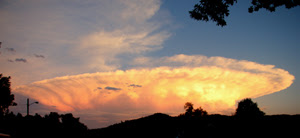 It's not often that you see any news or articles about fire weather forecasters. We have come to depend on them and we probably take them for granted, so it is refreshing to see them receive a little publicity. Here is an excerpt from a ScrippsNews article about Richard Thompson, from Oxnard, California.
It's not often that you see any news or articles about fire weather forecasters. We have come to depend on them and we probably take them for granted, so it is refreshing to see them receive a little publicity. Here is an excerpt from a ScrippsNews article about Richard Thompson, from Oxnard, California."But a lot of it also involves forecasting that relies as much on hunches and knowledge of local weather patterns as on science.
"The conditions can be pretty primitive out there," said Thompson, who works out of the National Weather Service office in Oxnard, "but it can also be very rewarding work."
Unlike the forecasts he produces behind a desk in Oxnard, Thompson's field work generates almost instant feedback from firefighters. "If your forecasts are accurate or bad, they'll let you know about them right away," he said.
Gary Montgomery, a rangeland management specialist in Los Padres National Forest, uses forecasts by incident meteorologists to decide where to send firefighters and equipment during wildfires."
(Photo by Bill Gabbert)
Wednesday, January 23, 2008
Man Charged for Starting Catalina Island Fire
"An Indiana man has been charged for allegedly starting the Santa Catalina Island fire in May, authorities said Tuesday.Gary Dennis Hunt, 49, was charged with two felony counts in his arrest warrant: one for recklessly causing a fire to an inhabited structure and one for recklessly causing a fire to a structure or forest. Three Catalina Island addresses were listed in the counts.
According to the Los Angeles County district attorney's office, Hunt was a subcontractor working on the island. Despite posted signs about extreme fire danger and prohibition of open flames, he allegedly used an open-flame torch on May 10 to cut the cables on the island's radio tower, Ambrose said.
That allegedly started the fire, which burned 4,750 acres and cost $5 million to fight."
Tuesday, January 22, 2008
Alabaugh Fire to be Part of 2008 Refresher Training
 Every spring the national wildland fire agencies produce and distribute a standardized training package designed to meet the requirements for 8 hours of refresher training for wildland firefighters. The training usually includes a description of unique incidents or near-misses that occurred in the previous season. This year the training will feature an entrapment of two firefighters on the Alabaugh fire in July of last year. On the fire, which started 5 miles southeast of Hot Springs, South Dakota, the firefighters escaped serious injuries by sharing one fire shelter.
Every spring the national wildland fire agencies produce and distribute a standardized training package designed to meet the requirements for 8 hours of refresher training for wildland firefighters. The training usually includes a description of unique incidents or near-misses that occurred in the previous season. This year the training will feature an entrapment of two firefighters on the Alabaugh fire in July of last year. On the fire, which started 5 miles southeast of Hot Springs, South Dakota, the firefighters escaped serious injuries by sharing one fire shelter.In addition to the photo with this post, the photo in the header at the top of this page is of the Alabaugh fire. In December the producers of the refresher training shot some video interviews at the houses that you can see in the header photo.
(Photo of Alabaugh fire by Bill Gabbert)
Saturday, January 19, 2008
Yes, Fires are Getting Larger

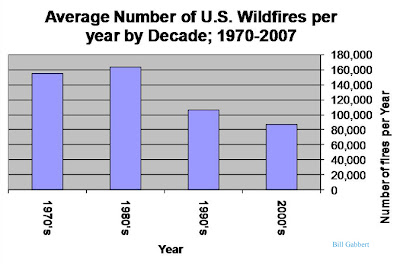
We all know that wildland fires are larger than they used to be. Almost every summer recently there are fires that exceed 100,000 acres. Before 1990 this was not common.
I analyzed some fire occurrence statistics obtained from the National Interagency Fire Center and the National Incident Information Center. The numbers for 2007 are through November 4, 2007. Usually when fire occurrence statistics are displayed you will see total acres and the number of fires by year. But when I computed the average size of fires for each decade, the 1970s through 2007, a trend is painfully obvious. During those four decades the average size of fires increased by 400%, while the average number of fires each year decreased by 44%. (Click on the graphs to make them larger.)
But why are fires larger? Some of the factors that could cause such an increase in the average size are:
- Fire suppression for the last 100 years is catching up with us. Preventing naturally occurring fires to routinely reduce the fuel loads increases the amount of fuel, and the continuity of it, available when a fire starts. Fires burn more intensely and with more resistance to control.
- Climate change. There is no doubt that temperatures in the last few decades have been higher that they were before this period. We can debate how this may have affected wildland fires. Many areas have had extended droughts, causing die back of brush and shrubs. Trees are stressed, making them more susceptible to insects and other pests. Do these higher temperatures have a direct effect on fire behavior on an hour by hour basis?
U. S. Wildland Fire Fatality Report--2007
 The Safety and Health Working Team, part of the National Wildfire Coordinating Group, on January 15 released a "Safety Gram" listing the wildland fire related fatalities in 2007.
The Safety and Health Working Team, part of the National Wildfire Coordinating Group, on January 15 released a "Safety Gram" listing the wildland fire related fatalities in 2007."Nine fatalities occurred in 2007 when employees were performing wildland fire management activities. This is a substantial decrease from the 24 fatalities that were reported in 2006. Also noteworthy is the absence of any entrapment or burnover related fatalities.
- Aviation – 1: Fatality occurred when helicopter was performing logistical support.
- Driving – 3: Fatalities occurred when firefighters were returning from a prescribed fire (1) and training (2).
- Hazard Tree/Snag – 1: Fatality occurred when a tree fell on a firefighter during chain saw training.
- Heart Attacks – 2: Fatalities occurred following the Work Capacity Test (pack test) and firefighting.
- Other – 2: Fatalities occurred when a dozer rolled over while constructing fire line (1) and by electrocution (1)."
Friday, January 18, 2008
Black Lining With a Machine
 The U.S. Fish and Wildlife Service in South Dakota has been experimenting with a tractor-towed machine that creates black lines which can be put in prior to a prescribed fire. Black lines, a relatively narrow strip of burned vegetation along the perimeter of a planned prescribed fire project, can make the ignition and holding of the main burn go much more quickly and also reduce the chance of a slop-over.
The U.S. Fish and Wildlife Service in South Dakota has been experimenting with a tractor-towed machine that creates black lines which can be put in prior to a prescribed fire. Black lines, a relatively narrow strip of burned vegetation along the perimeter of a planned prescribed fire project, can make the ignition and holding of the main burn go much more quickly and also reduce the chance of a slop-over.The equipment is made by Firebreak Equipment, a firm in South Africa. Their web site does not play well with Firefox--it's better with Internet Explorer. More photos are on their web album.
The device uses propane burners in a metal enclosure to burn the ground fuel, while water nozzles on the sides create a wet line to keep the fire from spreading. This
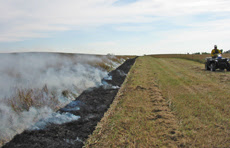 loo
loo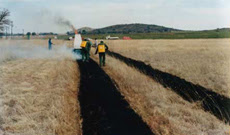 ks like it would be fun to play with.
ks like it would be fun to play with.
Two Fire Organizations for Women to Merge
Wayne National Forest Coal Refuse Fire
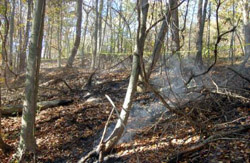 I have seen coal seam fires in Alaska that were started by lightning, but until today I had never heard of a "coal refuse fire". Apparently they are pretty common in southeast Ohio where the Wayne National Forest has been dealing with this mostly underground, one-acre "Coal Dale" fire since October 29. Now they are saying it is out.
I have seen coal seam fires in Alaska that were started by lightning, but until today I had never heard of a "coal refuse fire". Apparently they are pretty common in southeast Ohio where the Wayne National Forest has been dealing with this mostly underground, one-acre "Coal Dale" fire since October 29. Now they are saying it is out.According to the Logan Daily News:
"Using heavy equipment, D.J. Group, Inc. from Beverly spread the burning coal debris out onto a previously stripped mined area where it was extinguished. Once the material cooled, the entire area was graded to its original condition. This spring the area will be reseeded and planted with trees native to the area."Here is a link to the InciWeb info, but it has not been updated since November 20.
(photo by US Forest Service)
Wednesday, January 16, 2008
Well Written Reviews of Two Wildland Fire Books
A writer for the High Country News, Ray Ring, reviewed both new books, showing more understanding of fire than most reviewers. Here's a sample where Ring writes about "A Great Day to Fight Fire". (The entire review can be found on the Vail Trail site.)
"Matthews’ book on the gulch fire is the literary landmark there now. It’s also a kind of policy landmark. Matthews spends a few words on how the Mann Gulch deaths led to improvements in firefighting, but his underlying message is that, no matter what tactics we try, no matter what technologies we develop, wildfires will always be wild, chaotic and lethal. As global warming promotes more intense blazes, we can only reduce the risk of casualties by backing away from the flames. Let more fires burn on their own terms; that’s part of Matthews’ acceptance. And the next time prosecutors and next-of kin rush to assign blame for casualties, maybe we should hold off. The deaths and injuries radiating outward are already punishment enough. In the desperate moments when the flames come too close, we’re all perfect in our imperfections."
Major Die-Off of Lodgepoles in WY and CO
"The Rocky Mountain News reported this week that every large, mature forest of lodgepole pines in Colorado and southern Wyoming will be dead in three to five years."That sounds extreme. The conventional public and media "wisdom" is that it is caused by global warming. Warmer winters result in less mortality of pine bark beetles, causing more mortality of lodgepole pine.
But other factors are the drought (more stress on trees), and fire suppression (lodgepole stands are older and closer to their 200-300 year fire return interval and natural decadence).
But regardless of the reason, these stands are dieing now, and it could have a major effect on the resistance to control of fires in the area.
Leave a comment if you have any thoughts on this. You'll need to register with Google, but it's painless. Why Google, you ask? They bought blogger.com a couple of years ago, and they host these blogs. And, registering reduces spam in the comments.
 Cleveland National Forest Completes Hydromulch on Santiago Fire
Cleveland National Forest Completes Hydromulch on Santiago FireThe U.S. Forest Service completed their $5 million project to treat 1,241 acres with hydromulch in areas burned by the October fire in Orange County in southern California. The hydromulch is a wet mixture of 40% shredded wood and 60% paper with a gum-based tackifier, a sticky substance that helps the mulch material cling to terrain. Single engine air tankers and helicopters applied the green-dyed biodegradable material to help minimize erosion.
5th Fatality in Florida I-4 Smoke/Fog 50+ Vehicle Pileup
A 5th person has passed away as a result of the 50+ vehicle pileup that may have been caused by smoke from an escaped prescribed fire combining with fog on January 9. Smoke from the fire continues to cause lane closures on the Interstate. The Florida Division of Forestry is still mopping up the 380 acre fire which resulted from a prescribed fire conducted by the Florida Fish and Wildlife Conservation Commission. (see the posts on Jan. 9-10 for more information, here, here, and here)
Witch Creek Fire Was 2nd Costliest Disaster of 2007
The October Witch Creek fire which started near Santa Ysabel in San Diego County California was the second costliest incident in 2007 for insurance companies, causing $1.1 billion in damage. Started by downed power lines during a Santa Ana wind event, the fire burned 197,000 acres and destroyed 1,650 structures. The number one natural disaster for insurance companies was the four-day storm in mid-April that caused $1.3 billion in damages in 19 states.
Tuesday, January 15, 2008
Forest Fire J!had?
“summer has begun so do not forget the Forest J!had”and called on all Muslims in the United States, Europe, Russia and Australia to
“start forest fires.”The posting mentioned imprisoned Al Qaida terrorist Abu Musab Al-Suri, and went on to say:
“The idea of forest fires is attributed to him....”and:
“Imagine if, after all the losses caused by such an event, a j!hadist organization were to claim responsibility for the forest fires. You can hardly begin to imagine the level of the fear that would take hold of people in the United States, in Europe, in Russia, and in Australia.”
All of this may be nothing more than one crazed person ranting on the Internet, but we'll see what, if anything, develops.
(I changed the spelling of the J. word, replacing the "i" with a "!".)
USFS Employee Convicted of Starting Fire May Be Released From Prison Early

In 2003, Terry Barton, a U.S. Forest Service Fire Prevention Technician, was convicted of starting the 2002 Hayman fire on the front range of Colorado. She was sentenced to 12 years in prison by the state and 6 years by a federal court. In an appeal, the 12 year sentence was thrown out. Since she has already served 5 years, she could be released in a year. But it's not over yet. There is another hearing scheduled for February 11 when there could be another change related to the state sentence. Barton's attorneys are arguing that the state judge's sentencing decision, double the standard sentence, was affected by the fact that he voluntarily evacuated during the fire.
The Hayman fire burned 138,000 acres and 133 homes; 8,000 people were evacuated. Aside from prison, Barton also was ordered to pay $42.2 million in state and federal restitution.
Monday, January 14, 2008
IAWF Looking for Executive Director
The IAWF is a dynamic organization serving the wildland fire community. It could be a great job for someone with both organization management experience and a fire background. We have managed to double the membership in three years and are doing more to support wildland fire such as offering scholarships , helping to support the Wildland Firefighter Foundation, monitoring wildland fire legislation, issuing position papers, establishing a Wildland Fire Event Calendar, conducting surveys on important issues, increasing the publication frequency of the International Journal of Wildland Fire, and putting on a variety of well-attended conferences.
Sunday, January 13, 2008
Air Tanker Drops Retardant in Wilderness Area; No Fire Nearby
 Last year wilderness rangers in the Inyo National Forest in California began receiving reports from hikers about a red stain near the 13,200' Feather Peak in the John Muir Wilderness. It turned out to be retardant apparently dropped by an air tanker. This was very odd, since there had been no fire in the area.
Last year wilderness rangers in the Inyo National Forest in California began receiving reports from hikers about a red stain near the 13,200' Feather Peak in the John Muir Wilderness. It turned out to be retardant apparently dropped by an air tanker. This was very odd, since there had been no fire in the area.Further investigation uncovered the fact that it was dropped July 8, 2007 by the crew of Tanker 55, a P2V launched from Porterville, California. The flight crew initially said that the aircraft developed engine trouble and they jettisoned the 17,500 pounds of retardant for safety reasons. This is standard procedure during some types of in-flight emergencies--a lighter load makes it easier to fly a crippled airplane. The crew, however, did not report the engine problem, or request any repairs upon landing.
Because some aspects of the crew's story did not add up, US Forest Service Law Enforcement investigators got involved. There are indications now that there was no engine trouble, but the air crew had to dump the load somewhere, since they could not land with a full tank of retardant. Rather than drop it in the designated areas for retardant dumping, they, for some reason, chose to drop it near a peak in a wilderness area... a rocky peak with little vegetation. At 13,200', the red retardant will likely be visible for years before it degrades.
Saturday, January 12, 2008
L. Dean Clark Retires
 Last night I went to a party in Idaho Springs, Colorado, to recognize the wildland fire career of L. Dean Clark (on the left in the photo). On January 3 Dean retired from the National Park Service as Deputy Fire Management Officer for the Intermountain Region, working out of Denver. He began his career in California (a long time ago!). He worked at Yosemite, Pinnacles, Yellowstone, Bandelier, and many other locations. One thing he is remembered most for is his acceptance of an assignment at Bandelier National Monument shortly after the May,
Last night I went to a party in Idaho Springs, Colorado, to recognize the wildland fire career of L. Dean Clark (on the left in the photo). On January 3 Dean retired from the National Park Service as Deputy Fire Management Officer for the Intermountain Region, working out of Denver. He began his career in California (a long time ago!). He worked at Yosemite, Pinnacles, Yellowstone, Bandelier, and many other locations. One thing he is remembered most for is his acceptance of an assignment at Bandelier National Monument shortly after the May, The large crowd at the gathering passed the boot to collect donations for the Wildland Firefighter Foundation. Dean pledged to match a portion of the funds collected. Here is a 5 minute video that describes what the WFF does.
(Photo by Marsha Rogers)
Friday, January 11, 2008
Florida Prescribed Fire Had Unexpected Drop In RH
"A weather forecast from the forestry staff showed that the humidity would not drop below 60 percent all day, a crucial factor in determining whether to proceed with a burn. If humidity dropped to 30 percent or below, the Division of Forestry would have denied the permit.
A form that Burger filled out to document the controlled burn showed that the humidity measured 63 percent at 10 a.m. on Tuesday, so he and a crew of five other employees started the burn at 10:15 a.m. They expected to be finished by noon.
"They do a lot of prescribed burning, and they do a good job at it," said Department of Agriculture spokesman Terry McElroy. "But something apparently went awry."
To the crew's dismay, within an hour after they started the fire, the humidity abruptly dropped to 30 percent, Morse said. That wasn't part of the forecast, he said."
Thursday, January 10, 2008
Senator Baucus at Missoula Smoke Jumper Base
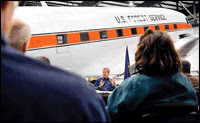 Montana Senator Max Baucus used the US Forest Service's DC-7 jump plane as a backdrop as he made a speech on Monday outlining two bills related to wildland fire:
Montana Senator Max Baucus used the US Forest Service's DC-7 jump plane as a backdrop as he made a speech on Monday outlining two bills related to wildland fire:- The Stable Fire Funding Act, which would establish a trust fund with $600 million in seed money for the Forest Service and $200 million in seed money for the Bureau of Land Management.
- Baucus included a provision in the America's Climate Security Act which was passed in December to provide up to $1.1 billion every year to combat catastrophic fires. The provision is intended to cover the annual cost to the federal government of the largest 1 percent of "escaped" fires, which currently account for 85 percent of wildfire suppression costs.
Air Force to Reimburse for Fire Costs
 On May 15, 2007, a New Jersey Air National Guard F-16 ejected a flare during a low-level pass on a training flight, starting a fire which grew to 17,000 acres. The fire destroyed four homes in two senior citizen housing developments, and damaged 37 others. Some 6,000 people were evacuated. Ocean County agencies will receive $320,000 from the Air Force as reimbursements for their costs during the fire. The Air Force has already paid nearly $2 million in private property claims and other losses, but many claims are still unsettled.
On May 15, 2007, a New Jersey Air National Guard F-16 ejected a flare during a low-level pass on a training flight, starting a fire which grew to 17,000 acres. The fire destroyed four homes in two senior citizen housing developments, and damaged 37 others. Some 6,000 people were evacuated. Ocean County agencies will receive $320,000 from the Air Force as reimbursements for their costs during the fire. The Air Force has already paid nearly $2 million in private property claims and other losses, but many claims are still unsettled.
Interstate 4 Pileup; Dozer Burned
"Smoke is going to continue to be our number one concern until this is over."The prescribed fire was conducted by the Florida Fish and Wildlife Conservation Commission who started it at 9 a.m. on Tuesday in an area called the Green Swamp. Within three hours it was out of control. Now it is 500 acres and 90% contained.
The Leger has more information about the escaped prescribed fire:
"As the flames picked up, Division of Forestry firefighter John Wurster arrived to help Fish and Wildlife workers. The workers were equipped with a bulldozer that was cutting a fireline in an attempt to stop the flames from spreading.
Conditions suddenly worsened. The wind changed, humidity dropped, and flames increased, Wurster said.
Ten minutes later, Wurster's fellow firefighter had been burned on his hand and face, the Division of Forestry had lost a $150,000 bulldozer, and firefighters were running from flames.
By late evening, nine Division of Forestry workers helped contain 90 percent of the fire. Smoke continued to billow from the swamp into the morning."
Wednesday, January 9, 2008
More Information About the 50-car Pile Up
"But news of a possible problem had been brewing since the night before.
The Division of Forestry notified the FHP at 7:03 p.m. Tuesday night of potential smoke problems from the controlled burn, as part of a formalized interagency agreement. FHP said they would monitor I-4 and close it if needed. FHP also notified the state Department of Transportation, which put out signs with flashing lights that warned of the smoke.
The National Weather Service in Melbourne this morning issued a special weather report warning commuters that visibility in the Polk County area would be down to zero because of smoke from brush fires and fog.
Throughout the day, officials disagreed about the role the smoke and fog played in the crash.
FHP Sgt. Jorge Delahoz said the smoke from the fire may have had some impact, but at the time of the crash it was the fog that reduced visibility in the area. He said people were probably driving at 50 or 70 miles per hour or faster.
A forestry official said he would not say conclusively what caused the pileup until his investigators issued a final report, possibly in the coming week. But the official cautioned that his team could be on scene of the burn for weeks, even months."
Smoke From Escaped Rx Fire and/or Fog Contribute to 3 Deaths & 50-Car Pileup
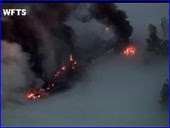
According to reports, smoke from an escaped prescribed fire combined with fog contributed to a 50-car pileup and three deaths on Interstate 4 in Florida between Orlando and Tampa. ABC Action News reported yesterday, January 8:
Then today ABC Action News further reports in a story about the incident:"POLK COUNTY-- Crews are working to put out an oversized brush fire in Polk County.
Officials with the Division of Forestry say they issued a 50 acre prescribed burn today in the area of Old Grade Road and I-4.
They believe the wind may have led the fire to grow by an extra 200 acres.
They say no homes are being threatened at this time.
There are concerns that if the fire burns overnight, drivers may face smoky conditions by Wednesday morning."
"A mixture of fog and smoke from a controlled burn near Old Grade Road created extremely hazardous conditions early this morning.More information from MyFox Tampa Bay:
The burn was supposed to cover only 50 acres, but got out of hand late yesterday and grew to more than 300 acres."
"POLK CITY - Smoke and fog are causing a surreal scene in Polk County that's forced the closure of a stretch of Interstate 4, and contributed to a massive pile-up.
All lanes of I-4 are closed between the Polk Parkway and U.S. 27. That's roughly from Polk City to the Osceola County line.
The lingering smoke combined with the morning fog has brought visibility down to near zero, and deputies say at least 50 vehicles are involved in the massive wreck, and 20 of those are semi-trucks. Several vehicles caught fire, though most of the blazes seemed to be out by 8:30 a.m., judging by the diminishing amount of black smoke rising from the scene.
At least three people are dead, and several more motorists are trapped and waiting for emergency crews.
Those who are unhurt are being asked to stay in their cars for their own safely and the safety of rescue workers.
Yesterday's brush fire began as a controlled burn, but it jumped a firebreak and eventually grew to 250 acres before being contained."
According to TheLedger.com a Division of Forestry dozer was burned in the fire yesterday.
Tuesday, January 8, 2008
Wildland Fire Scholarships

The International Association of Wildland Fire just sent out this announcement:
"In 2008 the International Association of Wildland Fire (IAWF) will be again awarding two graduate-level scholarships each valued at $2,500USD to Master of Science (M.Sc.) or Ph.D. students studying wildland fire or wildland fire-related topics. These scholarships are not intended for Masters of Forestry degrees in wildland fire or for non-thesis graduate programs.
One of the two scholarships will be awarded to a student from the United States or Canada, and the other will be awarded to an individual from outside of these two countries. The application period will open January 15 and close March 31, 2008. Award winners will be announced the following May.
For more information, including how to apply, see the web site"
Monday, January 7, 2008
Women in Fire, 24 Hours of Sunlight

Kelly Homstad has organized a team of three female wildland firefighters who will compete in a 24 hour endurance race, "24 Hours of Sunlight". It will include hiking and skiing or snowshoeing up and down a mountain for the entire 24 hour period. It will take place at Sunlight Mountain Resort near Glenwood Springs Colorado February 23-24, 2008. They are looking for sponsors to subsidize some of the costs faced by their team members including the registration fee ($125 per racer), and also food, water and incidental expenses on race day.
Here is How Kelly describes the team:
"We are three gals with a passion for fire! I'm a Fire and Fuels Specialist, in Montrose, Colorado. I've been in fire for 5 years. The team captain, Faith Gall, is an Engine Foreman in Rifle, Colorado, going on 11 years in fire. Last, but definitely not least, is Jenna Beckerman, who is on the Craig Hotshots, in Craig, Colorado. Jenna has been in fire for 4 years. We believe this race will be a fun and challenging way to stay fit for next fire season."You can contact Kelly at karky_20@yahoo.com
Sunday, January 6, 2008
Allstate Insurance: $315-335 million in So. Calif. Fire Losses

According to CNNMoney.com
"Allstate Corp. said late Tuesday it has received more than 7,000 claims from the Southern California wildfires in October, resulting in roughly $315 million to $335 million in wildfire-related catastrophe losses to be recorded in fourth quarter."
I wonder if this will motivate the insurance companies to work with homeowners to make their property more resistant to wildland fires?
Federally funded wildfire sprinklers?

If you live in St. Louis or Lake counties in Minnesota, you could be eligible to submit an application for grant assistance to install or upgrade a wildfire sprinkler system. According to the Timberjay newspaper:
"Both counties will be seeking federal funding through FEMA to help pay the cost of installing sprinkler systems for homeowners, especially for those in areas identified as at high risk for wildfire."
Should the federal government be buying sprinklers to be installed on private land?
2007 - Second Costliest Fire Season on Record

According to the Associated Press, 2007 was the second costliest season ever.
The emphasis in the story on the use of retardant is interesting. This will only reinforce the impression in the public that air tankers are the answer to keeping fires small, while the truth is, large wind-driven fires are not suppressed by air tankers."BOISE, Idaho -- Wildfires scorched an area four times the size of Yellowstone National Park and destroyed more than 5,200 buildings in 2007, one of the nation's worst fire seasons despite a record amount of retardant dropped by aircraft.
The Boise-based National Interagency Fire Center reported nearly 14,000 square miles burned and the federal government spent more than $1.8 billion fighting wildfires, making it the second costliest season on record.
Even though fire managers used 22.4 million gallons of fire retardant - nearly triple the 10-year average - the area burned in 2007 trails only 2006 when fire consumed 15,500 square miles.
The number of buildings burned in 2007 ranks second since current counting methods began in 1999, trailing the 5,700 buildings destroyed in 2003, the fire center reported."
(Photo by Bill Gabbert)
Wildland Firefighter Fitness
Do we need an interagency program to:
- Encourage fitness;
- Provide guidelines about how to achieve and maintain physical fitness year round?
And I don't want to get into a discussion on the merits of fitness tests like the Pack Test.
Post Number 1: The Beginning
As the new year begins, so does Wildfire Today. I hope, with this web site, to bring to light some of the current issues, news, and
We encourage comments about the posts. In order to reduce the number of automated spam comments, you will need to have a Google account. It's easy to sign up and is free.




